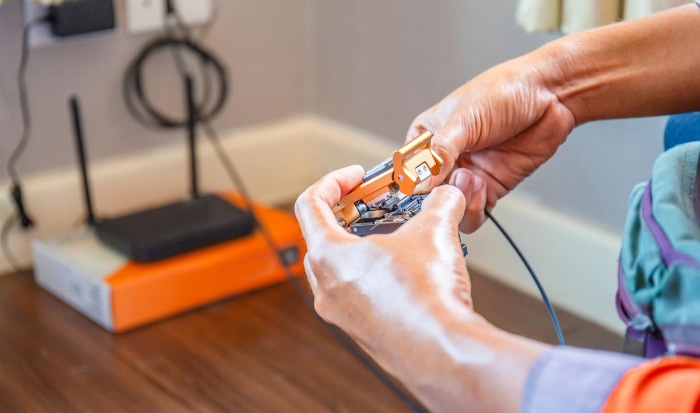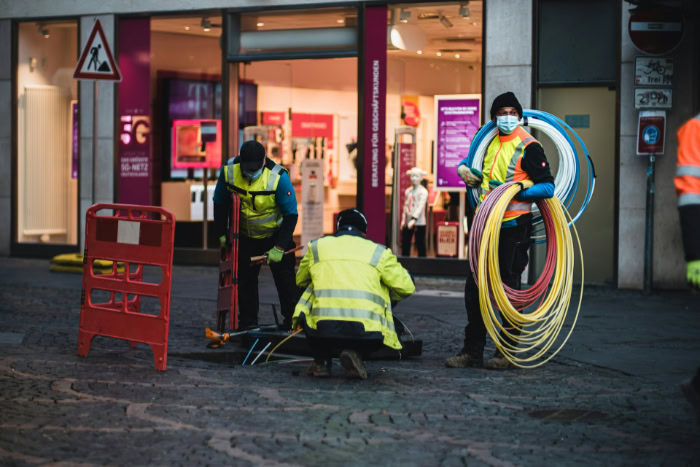Pros and Cons of Fiber Optic Internet: Is It Worth the Cost?

The demand for faster, more reliable internet has never been greater, and fiber optic technology is stepping up to the plate as a game-changer in modern connectivity. Leveraging the power of light to transmit data, fiber optic internet offers unprecedented speed, stability, and efficiency for homes and businesses alike.
As activities like streaming high-definition content, online gaming, and cloud-based work tools become more essential, many are considering whether fiber optics are worth the investment.
Technical Advantages of Fiber Optic Internet
Fiber optic internet offers a range of technical benefits that set it apart from traditional broadband options like cable or DSL. Designed to handle the data demands of today and tomorrow, it utilizes light to transmit information at incredible speeds.
Its unique properties also provide outstanding reliability, signal clarity, and support for emerging technologies. For users who require consistent, high-performance connectivity, fiber optic internet stands as one of the most advanced solutions currently available.
Unmatched Speed and Bandwidth
The technology behind fiber optic internet allows for some of the fastest connection speeds accessible to consumers. With symmetrical upload and download rates reaching up to 10 Gbps in many cases, it accommodates virtually any online activity effortlessly.
Activities such as streaming 4K or even 8K content, conducting telehealth appointments, or integrating a growing number of Internet of Things (IoT) devices are supported without the buffering or bottlenecks common with other internet types.
Bandwidth capacity is equally noteworthy, enabling multiple users to connect to the internet simultaneously without degradation in quality. Large households or businesses can rely on this level of performance for everything from casual browsing to bandwidth-intensive tasks like cloud computing.
Fiber optic internet caters to environments where high-speed and uninterrupted connectivity has become a necessity instead of a luxury.
Reliability and Signal Integrity
Fiber optic cables are inherently more durable and resistant to common interference issues than traditional copper lines. Because the system uses light signals instead of electrical ones, electromagnetic interference from other devices or nearby power lines does not affect its performance.
Even during extreme weather conditions, connections typically remain consistent, ensuring uninterrupted service when it matters most.
Signal integrity also stands out as a major advantage. While copper cables often experience signal degradation over long-distance transmissions, fiber optics excel at maintaining quality regardless of the distance.
This consistency can make a significant difference for users in rural areas or businesses that rely on extensive networking systems. Fiber optic internet’s ability to deliver reliable and unhampered service is one of its strongest attributes.
Low Latency
For applications where timing is critical, such as online gaming, video conferencing, or virtual reality, low latency is a highly sought-after feature. Fiber optic internet is designed to minimize delays in data transmission, resulting in a smoother online experience.
The quick exchange of information ensures that gamers can enjoy real-time responsiveness during competitive matches, and remote workers can video conference without lag.
Latency improvements also play a vital role in supporting emerging technologies that require split-second data exchanges. For households or businesses integrating smart devices, cloud services, or automation solutions, fiber optics deliver the level of responsiveness required to optimize performance.
By reducing delays, it allows users to stay connected and productive, no matter how demanding their online activities may be.
Economic Considerations

Adopting fiber optic internet involves financial factors that play a significant role in decision-making for both residential and commercial users. While the technology is renowned for its superior performance, the costs associated with its implementation and maintenance can impact its accessibility.
However, the investment often proves worthwhile in the long run, given the benefits of reduced operational expenses, future scalability, and improved productivity.
Upfront Costs
The initial expenses of fiber optic internet can be higher than those of traditional broadband options. Specialized labor is required for installation, as the process demands expertise in handling and connecting fiber optic cables.
Infrastructure upgrades may also be necessary, especially in areas where fiber networks are not yet established. These factors contribute to higher costs, making the technology less accessible in regions with minimal investment in fiber deployment.
Geography also affects the cost of implementation, particularly in rural areas. Extending fiber optic networks to underserved locations often involves substantial investments in laying cables over long distances.
This challenge can delay or limit the availability of fiber internet in such areas, leaving them reliant on slower or less consistent alternatives. The higher upfront expenses associated with fiber optics are a drawback for many, particularly in regions where affordability is a concern.
Long-Term Value
While the installation costs may seem significant, fiber optic internet is often regarded as a long-term investment that pays off over time. The infrastructure requires less maintenance compared to traditional copper networks, as fiber optic cables are more resistant to environmental wear and tear.
Lower maintenance demands reduce ongoing costs, making fiber optics a more cost-effective solution in the years following installation. Additionally, the energy efficiency of fiber networks contributes to operational savings, as they consume less power than older technologies.
Scalability is another economic advantage of fiber optic infrastructure. As data demands grow, fiber networks are equipped to handle higher bandwidth requirements without the need for major upgrades.
This ability to adapt to future technological advancements makes fiber optics a forward-thinking choice, particularly for businesses and households that want to ensure their internet capabilities remain relevant in the coming years. The future-proof nature of fiber networks solidifies their position as a valuable long-term solution.
Business ROI
For enterprises, fiber optic internet offers clear advantages in enhancing productivity and driving profitability. Businesses that rely on cloud-based operations, such as file storage, collaboration tools, and data analytics, benefit from the high speeds and low latency of fiber connections.
Reliable, fast internet ensures uninterrupted access to essential systems, reducing downtime and improving overall efficiency.
The ability to support seamless communication and collaboration also makes fiber optic internet a valuable asset for remote work environments. Employees can engage in video conferences, share large files, and access company systems without delays, fostering a more productive and connected workforce.
Additionally, enterprises that deal with large-scale data transfers or bandwidth-intensive operations, such as media production or financial trading, find fiber networks indispensable. The improved efficiency and capability offered by fiber optics often lead to a return on investment that justifies the initial expenses.
Practical Limitations and Challenges

Fiber optic internet offers impressive performance, but it is not without practical challenges that may affect its feasibility for certain users. Limitations in coverage, issues related to the physical structure of the cables, and dependence on external power sources introduce obstacles that need to be considered.
Availability and Accessibility
One of the most significant barriers to fiber optic adoption is its limited availability in certain areas. Urban and suburban regions tend to have better access due to higher population density and greater infrastructure investment.
Conversely, underserved or rural regions often face significant gaps in coverage. Deploying fiber optic networks in these areas is costly and labor-intensive, which can deter internet service providers from expanding their reach.
Fiber optic availability also hinges on the investments made by local ISPs. Building the necessary infrastructure requires substantial capital, and some providers may prioritize more populated regions where the return on investment is higher.
As a result, customers in smaller towns and rural areas are often left with slower or less reliable alternatives, further widening the connectivity gap.
Physical Fragility
Fiber optic cables, while highly efficient, are more delicate than traditional copper wiring. During installation or construction projects, cables may be inadvertently damaged, leading to service interruptions.
The precision required to handle and install these cables adds to the complexity of the process compared to older broadband technologies.
Repairing fiber optic cables also poses unique challenges. Specialized technicians and equipment are needed to locate and fix damaged sections, which can result in higher repair costs and longer wait times for service restoration.
The fragility of fiber cables is a drawback for users in areas prone to frequent construction work or natural disturbances that could disrupt the system.
Power Dependency
While fiber optic internet itself does not use electricity to transmit data, the associated equipment such as modems, routers, and Optical Network Terminals (ONTs) relies on a stable power source. In the event of a power outage, fiber internet connections become inoperable unless backup power solutions, such as uninterruptible power supplies (UPS) or generators, are in place.
This dependency on power can be a disadvantage for users in locations where outages are frequent or prolonged. For businesses, losing access to the internet during power failures can hinder operations and productivity.
Home users who rely on fiber internet for work-from-home arrangements or entertainment may also find this limitation disruptive, especially without preparation for such scenarios.
Security and Use Case Suitability

Fiber optic internet offers benefits that go beyond speed and reliability, making it an ideal choice for users prioritizing data security and advanced technology applications. Its unique design provides enhanced protection against cyber threats, ensuring a safer online environment.
Additionally, its adaptability to both residential and commercial needs highlights its broad usability, while compatibility with emerging technologies positions it as a future-ready solution.
Enhanced Data Security
The structure of fiber optic cables makes them inherently more secure than traditional copper lines. Unlike electrical signals, light-based data transmission cannot be intercepted via electromagnetic eavesdropping, reducing the risk of unauthorized access.
Additionally, attempts to tamper with fiber cables often result in noticeable disruptions, alerting users to potential security threats. This makes fiber optics a popular choice for industries handling sensitive information, such as finance and healthcare.
Organizations that deal with confidential data require internet solutions that prioritize security. Fiber optic internet aligns with this need by offering a safer foundation for activities like financial transactions, medical record sharing, and secure communication.
Businesses looking to safeguard their client information often regard fiber optics as a dependable option for enhancing data protection.
Residential vs. Commercial Use
The advantages of fiber optic technology extend across residential and commercial applications, catering to the diverse needs of individual users and enterprises. For households, fiber internet supports seamless streaming, online gaming, and the integration of smart home devices.
Families can enjoy uninterrupted entertainment while maintaining connections for work-from-home setups or online learning environments. Its reliability ensures that all users within a household experience consistent performance, even during peak usage times.
On the commercial side, enterprises benefit significantly from the high-speed data transfers and low latency offered by fiber optics. Businesses relying on cloud-based workflows and remote collaboration tools experience improved operational efficiencies, as delays or interruptions become less common.
Video conferencing, large-scale data exchanges, and distributed workforce models are all supported effectively with fiber optic internet, offering a competitive advantage for modern companies in almost any industry.
Compatibility with Emerging Technologies
Fiber optic internet serves as a foundational technology for many cutting-edge advancements. Its capacity to handle large amounts of data at high speeds aligns perfectly with the requirements of emerging systems like 5G networks, artificial intelligence (AI), and virtual or augmented reality (VR/AR) applications.
As these technologies continue to evolve, the role of fiber optics in supporting their development and deployment will grow even further.
For users integrating smart infrastructure into their homes or businesses, fiber internet ensures the responsiveness needed for automation and enhanced connectivity. Applications involving VR-based training, AI-driven analytics, or immersive entertainment rely heavily on high-bandwidth, low-latency networks.
Fiber optics provides the backbone for such innovations, facilitating smoother implementation and greater operational efficiency.
Conclusion
Fiber optic internet stands out as a transformative technology, offering unmatched speed, reliability, and security. Its ability to support heavy data usage, future-proof connectivity, and advanced applications makes it an appealing choice for both households and businesses.
However, its benefits come with certain challenges, such as higher upfront costs, limited availability in rural areas, and dependency on stable power systems. These limitations can make it less accessible or practical in some cases, particularly for regions with less-developed infrastructure.
Choosing fiber optic internet involves weighing its advantages against the logistical and financial barriers associated with installation and maintenance. Evaluating factors like geographic location, budget constraints, and specific internet usage requirements is crucial to determining its suitability.
For those who can overcome the initial challenges, fiber optics offer a powerful and reliable internet solution capable of meeting the growing demands of a highly connected world.



